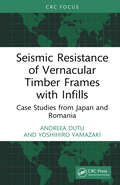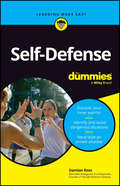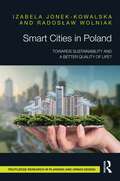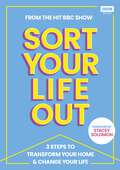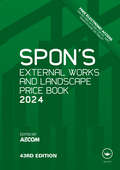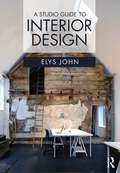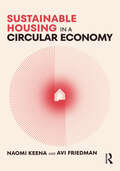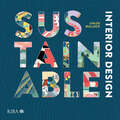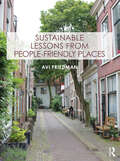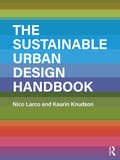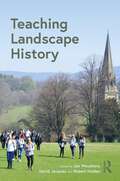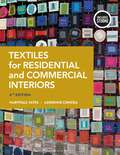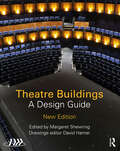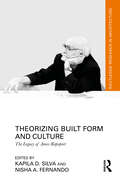- Table View
- List View
Seismic Resistance of Vernacular Timber Frames with Infills: Case Studies from Japan and Romania
by Andreea Dutu Yoshihiro YamazakiThis book provides an engineer’s perspective on the traditional construction methods for timber frames with infills, focusing on traditional paianta houses in Romania and minka houses in Japan to provide insights into the construction, seismic behavior, and design considerations of such structures.The nuances of each country’s traditional construction methods are considered, as well as the shared seismic culture and the similar functionality and local materials used for the houses, plus challenges from earthquake loading and fire. The efforts to preserve traditional houses in Romania are contrasted with Japan’s regulatory framework for traditional residential construction methods. Strengthening solutions are also proposed for timberframed houses with infills, considering various causes of degradation.• Introduces examples from non- seismic and seismic- prone countries.• Provides a comparative analysis of worldwide examples.• Presents design examples illustrating the integration of traditional architecture with modern design standards.The book serves as a comprehensive guide to the engineering intricacies of traditional houses in Romania and Japan for engineers and architects, with practical applications for new constructions worldwide.
Self-Defense For Dummies
by Damian RossGet street-smart. Unleash your inner warrior. Forget everything you thought you knew about self-defense. Those graceful martial arts moves that are so effective in the movies are likely to get you killed on the street. In fight-or-flight mode, you won’t have the calm thinking and fine motor skills to execute them. You need a simpler approach with a few fundamental moves that are easy to remember and perform yet devastating to an attacker. The solution? Self-Defense For Dummies, your guide to avoiding attacks, neutralizing attackers, and protecting yourself and your loved ones. In this book, you discover a self-defense system that works in the real world, where armed criminals target the most vulnerable and don’t fight fair. Discover strategies to make yourself a hard target, as opposed to an easy one Heighten your awareness of your surroundings and potential threats Sharpen your self-defense instincts and respond proactively to impending danger Master hand-to-hand combat basics and defend against grabs and holds Learn how to use weapons and defend against them
Self-Defense For Dummies
by Damian RossGet street-smart. Unleash your inner warrior. Forget everything you thought you knew about self-defense. Those graceful martial arts moves that are so effective in the movies are likely to get you killed on the street. In fight-or-flight mode, you won’t have the calm thinking and fine motor skills to execute them. You need a simpler approach with a few fundamental moves that are easy to remember and perform yet devastating to an attacker. The solution? Self-Defense For Dummies, your guide to avoiding attacks, neutralizing attackers, and protecting yourself and your loved ones. In this book, you discover a self-defense system that works in the real world, where armed criminals target the most vulnerable and don’t fight fair. Discover strategies to make yourself a hard target, as opposed to an easy one Heighten your awareness of your surroundings and potential threats Sharpen your self-defense instincts and respond proactively to impending danger Master hand-to-hand combat basics and defend against grabs and holds Learn how to use weapons and defend against them
Smart Cities in Poland: Towards sustainability and a better quality of life?
by Izabela Jonek-Kowalska Radosław WolniakThis book considers and examines the concept of a Smart City in the context of improving the quality of life and sustainable development in Central and Eastern European cities. The Smart City concept has been gaining popularity in recent years, with supporters considering it to be an effective tool to improve the quality of life of the city’s residents. In turn, opponents argue that it is a source of imbalance and claim that it escalates the problems of social and economic exclusion. This book, therefore, assesses the quality of life and its unsustainability in Central and Eastern European cities within the context of the Smart City concept and from the perspective of key areas of sustainable development. Using case studies of selected cities in Central and Eastern Europe and representative surveysof Polish cities, this book illustrates the process of creating smart cities and their impact on improving the quality of life of citizens. Specifically, this book investigates the conditions that a Smart City has to meet to become sustainable, how the Smart City concept can support the improvement of the residents’ quality of life and how Central and Eastern European countries create smartcity solutions. Containing both theoretical and practical content, this book will be of relevance to researchers and students interested in smart cities and urban planning, as well as city authorities and city stakeholders who are planning to implement the Smart City concept.
Smart Cities in Poland: Towards sustainability and a better quality of life?
by Izabela Jonek-Kowalska Radosław WolniakThis book considers and examines the concept of a Smart City in the context of improving the quality of life and sustainable development in Central and Eastern European cities. The Smart City concept has been gaining popularity in recent years, with supporters considering it to be an effective tool to improve the quality of life of the city’s residents. In turn, opponents argue that it is a source of imbalance and claim that it escalates the problems of social and economic exclusion. This book, therefore, assesses the quality of life and its unsustainability in Central and Eastern European cities within the context of the Smart City concept and from the perspective of key areas of sustainable development. Using case studies of selected cities in Central and Eastern Europe and representative surveysof Polish cities, this book illustrates the process of creating smart cities and their impact on improving the quality of life of citizens. Specifically, this book investigates the conditions that a Smart City has to meet to become sustainable, how the Smart City concept can support the improvement of the residents’ quality of life and how Central and Eastern European countries create smartcity solutions. Containing both theoretical and practical content, this book will be of relevance to researchers and students interested in smart cities and urban planning, as well as city authorities and city stakeholders who are planning to implement the Smart City concept.
SORT YOUR LIFE OUT: 3 Steps to Transform Your Home & Change Your Life
by The teamThe first official book from the life-changing BBC One show, Sort Your Life Out will have you falling back in love with your home in three simple steps:1. STRIP - how to let go and clear out the clutter (when you don't have a warehouse to hand)!2. SORT - time to sell, donate, recycle and upcycle.3. SYSTEMISE - learn how to organise, fold and store in a way that is manageable and sustainable.Filled with every tip and trick from your favourite experts Stacey, Dilly, Iwan and Rob, this empowering book will give you the tools to transform your home and get that Sort Your Life Out mindset.
Spon's External Works and Landscape Price Book 2024 (Spon's Price Books)
Compiled by AECOM, the 2024 edition has been updated with the latest pricing information to help you manage your projects over the next 12 months through this challenging period of high inflation and financial uncertainty. It covers all the items to be found in hard and soft landscape contracts, and forms an indispensable reference book for quantity surveyors, landscape architects, contractors and local authority managers – essential for compiling estimates, specifications, bills of quantities and works schedules – no matter what the size of the project being undertaken. All prices have been updated via a short-term inflationary forecast combined with AECOM’s market intelligence to ensure you have the most accurate cost data available. Activity descriptions and build ups have been updated to reflect changes to standard specifications, Building Regulation changes, emerging practices, and changing outputs All the standard features you have come to expect from SPON'S are also included: Material and measured work prices covering contract items from preliminaries and site clearance and encompassing the core external works activities Full breakdowns into labour, materials and other components Detailed guidance on wage rates, landscape consultants’ fee scales An extensive Approximate Estimates section for rapid spot estimating Included within the inside front cover of every book is a VitalSource eBook redemption code giving one user access to the content digitally until the end of December 2024.
Spon's External Works and Landscape Price Book 2024 (Spon's Price Books)
Compiled by AECOM, the 2024 edition has been updated with the latest pricing information to help you manage your projects over the next 12 months through this challenging period of high inflation and financial uncertainty. It covers all the items to be found in hard and soft landscape contracts, and forms an indispensable reference book for quantity surveyors, landscape architects, contractors and local authority managers – essential for compiling estimates, specifications, bills of quantities and works schedules – no matter what the size of the project being undertaken. All prices have been updated via a short-term inflationary forecast combined with AECOM’s market intelligence to ensure you have the most accurate cost data available. Activity descriptions and build ups have been updated to reflect changes to standard specifications, Building Regulation changes, emerging practices, and changing outputs All the standard features you have come to expect from SPON'S are also included: Material and measured work prices covering contract items from preliminaries and site clearance and encompassing the core external works activities Full breakdowns into labour, materials and other components Detailed guidance on wage rates, landscape consultants’ fee scales An extensive Approximate Estimates section for rapid spot estimating Included within the inside front cover of every book is a VitalSource eBook redemption code giving one user access to the content digitally until the end of December 2024.
A Studio Guide to Interior Design
by Elys JohnA Studio Guide to Interior Design leads you through the creative process of developing an interior design proposal. From reading existing buildings, to presenting the final design, each stage is illustrated with analytical diagrams demonstrating clearly the workflow, processes and skills needed at each stage of the design process. Throughout the book there are key references to drawing, digital practice, author illustrated diagrams and design precedents. The book shows how to effectively read existing architecture and interiors and sets out orthographic drawing principles, to be used as an integral part of conceptual design development. It also looks at the integration of technology within the design process. The book has a complementary focus towards hand drawing and digital practice and uses a case study driven, diagrammatic approach so students can readily apply programmatic concepts to their own project context. Ideally suited to students at the beginning of their course, the book covers everything students need to get to grips with early on in their studies and features a wealth of pedagogical features.
A Studio Guide to Interior Design
by Elys JohnA Studio Guide to Interior Design leads you through the creative process of developing an interior design proposal. From reading existing buildings, to presenting the final design, each stage is illustrated with analytical diagrams demonstrating clearly the workflow, processes and skills needed at each stage of the design process. Throughout the book there are key references to drawing, digital practice, author illustrated diagrams and design precedents. The book shows how to effectively read existing architecture and interiors and sets out orthographic drawing principles, to be used as an integral part of conceptual design development. It also looks at the integration of technology within the design process. The book has a complementary focus towards hand drawing and digital practice and uses a case study driven, diagrammatic approach so students can readily apply programmatic concepts to their own project context. Ideally suited to students at the beginning of their course, the book covers everything students need to get to grips with early on in their studies and features a wealth of pedagogical features.
Sustainable Housing in a Circular Economy
by Naomi Keena Avi FriedmanThis book relates circular economy principles to housing design and construction and highlights how those principles can result in both monetary savings, positive environmental impact, and socio-ecological change.Chapters focus on three key circular economy principles and apply them to architectural construction and design, namely rethinking of the end-of-use phase of a building and the potential of design-for-disassembly; the role of digitization and data standardization in fostering evidence-based circular economy design decision-making; and presenting space as a resource to conserve, via exploration of the sharing economy and flexibility principles. Beyond waste management and material cycles, this book provides a holistic understanding of the opportunities across the building life cycle that can allow for sustainable and affordable circular housing. With case studies from 13 different countries, including but not limited to the Hammarby Sjöstad district in Sweden, the Circle House in Denmark, Benny Farm in Canada, VMD Prefabricated House in Mexico, and the Deep Performance Dwelling in China, authors pair theoretical frameworks with real-world examples.This will be a useful resource for upper-level students and academics of architecture, construction, and planning, especially those studying and researching housing design, building technology, green project management, and environmental design.
Sustainable Housing in a Circular Economy
by Naomi Keena Avi FriedmanThis book relates circular economy principles to housing design and construction and highlights how those principles can result in both monetary savings, positive environmental impact, and socio-ecological change.Chapters focus on three key circular economy principles and apply them to architectural construction and design, namely rethinking of the end-of-use phase of a building and the potential of design-for-disassembly; the role of digitization and data standardization in fostering evidence-based circular economy design decision-making; and presenting space as a resource to conserve, via exploration of the sharing economy and flexibility principles. Beyond waste management and material cycles, this book provides a holistic understanding of the opportunities across the building life cycle that can allow for sustainable and affordable circular housing. With case studies from 13 different countries, including but not limited to the Hammarby Sjöstad district in Sweden, the Circle House in Denmark, Benny Farm in Canada, VMD Prefabricated House in Mexico, and the Deep Performance Dwelling in China, authors pair theoretical frameworks with real-world examples.This will be a useful resource for upper-level students and academics of architecture, construction, and planning, especially those studying and researching housing design, building technology, green project management, and environmental design.
Sustainable Interior Design
by Chloe BullockWhat does it mean to be a sustainable interior designer? Where do you start? This book demystifies how to be a sustainable interior designer, both within practice and on design projects. It gives you the tools to educate clients that sustainable practice isn’t necessarily more expensive, and what the options available to them are in terms of design concept, materials and finishes. Importantly, the book also looks at sustainable supply chains, particularly important when specifying FF+E. Where to start being sustainable can be a difficult decision. Acting as a primer for interior designers at any stage of their career, it outlines what you really need – and don’t need – to know. Inspirational case studies from around the world sit alongside crucial guidance on the benefits of being sustainable and how to work with enlightened clients. There is information on how sustainable design contributes to health and wellbeing, all backed up by authoritative best practice guidance.
Sustainable Interior Design
by Chloe BullockWhat does it mean to be a sustainable interior designer? Where do you start? This book demystifies how to be a sustainable interior designer, both within practice and on design projects. It gives you the tools to educate clients that sustainable practice isn’t necessarily more expensive, and what the options available to them are in terms of design concept, materials and finishes. Importantly, the book also looks at sustainable supply chains, particularly important when specifying FF+E. Where to start being sustainable can be a difficult decision. Acting as a primer for interior designers at any stage of their career, it outlines what you really need – and don’t need – to know. Inspirational case studies from around the world sit alongside crucial guidance on the benefits of being sustainable and how to work with enlightened clients. There is information on how sustainable design contributes to health and wellbeing, all backed up by authoritative best practice guidance.
Sustainable Lessons from People-Friendly Places
by Avi FriedmanCurrent planning and design modes of cities are facing challenges of philosophy and form. Past approaches no longer sustain new demands and call for innovative thinking. In a world that is becoming highly urbanized, the need for a new outlook is propelled by fundamental global changes that touch upon environmental, economic and social aspects.The book introduces fundamental principles of timely sustainable urban design, paying attention to architecture, integration of natural features, public urban spaces and their successful use. Readers will learn how cities are transitioning to active mobility by placing the wellbeing of citizens at the heart of planning; making buildings fit nature; supporting local culture through preservation; and including community gardens in neighborhoods, among others. Written by a practicing architect, professor and author, the book is richly illustrated and features meticulously selected international case studies.
Sustainable Lessons from People-Friendly Places
by Avi FriedmanCurrent planning and design modes of cities are facing challenges of philosophy and form. Past approaches no longer sustain new demands and call for innovative thinking. In a world that is becoming highly urbanized, the need for a new outlook is propelled by fundamental global changes that touch upon environmental, economic and social aspects.The book introduces fundamental principles of timely sustainable urban design, paying attention to architecture, integration of natural features, public urban spaces and their successful use. Readers will learn how cities are transitioning to active mobility by placing the wellbeing of citizens at the heart of planning; making buildings fit nature; supporting local culture through preservation; and including community gardens in neighborhoods, among others. Written by a practicing architect, professor and author, the book is richly illustrated and features meticulously selected international case studies.
The Sustainable Urban Design Handbook
by Nico Larco Kaarin KnudsonThe Sustainable Urban Design Handbook gathers the best sustainability practices and latest research from the fields of architecture, landscape architecture, planning, development, ecology, and environmental engineering and presents them in a graphically rich and accessible format that can help guide urban design decisions in cities of all sizes.The book presents a comprehensive framework that organizes more than 50 elements of sustainable urban design under five main topics–Energy Use & Greenhouse Gas, Water, Ecology & Habitat, Energy Use & Production, and Equity & Health–and relative to four project scales: Region & City, District & Neighborhood, Block & Street, and Project & Parcel. Each element chapter includes a summary of importance and background, compares typical practices and recommended approaches, explains connections to other elements, and concludes with urban design guidelines that can be used to directly inform projects and decisions.Easy to use and reference, The Sustainable Urban Design Handbook provides both an in-depth introduction to topics across sustainable urban design and serves as an on-going reference for anyone involved in the creation of sustainable urban environments. This resource will be useful to design and planning professionals, community members, students, and elected officials in guiding decisions about our sustainable future.
The Sustainable Urban Design Handbook
by Nico Larco Kaarin KnudsonThe Sustainable Urban Design Handbook gathers the best sustainability practices and latest research from the fields of architecture, landscape architecture, planning, development, ecology, and environmental engineering and presents them in a graphically rich and accessible format that can help guide urban design decisions in cities of all sizes.The book presents a comprehensive framework that organizes more than 50 elements of sustainable urban design under five main topics–Energy Use & Greenhouse Gas, Water, Ecology & Habitat, Energy Use & Production, and Equity & Health–and relative to four project scales: Region & City, District & Neighborhood, Block & Street, and Project & Parcel. Each element chapter includes a summary of importance and background, compares typical practices and recommended approaches, explains connections to other elements, and concludes with urban design guidelines that can be used to directly inform projects and decisions.Easy to use and reference, The Sustainable Urban Design Handbook provides both an in-depth introduction to topics across sustainable urban design and serves as an on-going reference for anyone involved in the creation of sustainable urban environments. This resource will be useful to design and planning professionals, community members, students, and elected officials in guiding decisions about our sustainable future.
Teaching Landscape History
Landscape history is changing in content and style to address the issues of today. Experienced teachers and authors on the history of gardens and landscapes come together in this new volume to share ideas on the future of teaching history in departments of landscape architecture, archaeology, geography and allied subjects. Design history remains important, but this volume brings to the fore the increasing importance of environmental history, economic history, landscape history, cultural landscapes, environmental justice and decolonisation, ideas of sustainability and climate change amelioration, which may all be useful in serving the needs of a widening range of students in an increasingly complex world. The main themes include: what history should we narrate in the education of landscape architects? how can we recognise counter-narratives and our own bias? how should we engage the students in the history of their chosen profession? how can designers and researchers be persuaded of the relevance of history teaching to theory and practice? and what resources do we need to develop teaching of landscape histories? This book will be of interest to anyone teaching courses on landscape architecture, urban design, horticulture, garden design, architectural history, cultural geography and more.
Teaching Landscape History
by Jan Woudstra David JacquesLandscape history is changing in content and style to address the issues of today. Experienced teachers and authors on the history of gardens and landscapes come together in this new volume to share ideas on the future of teaching history in departments of landscape architecture, archaeology, geography and allied subjects. Design history remains important, but this volume brings to the fore the increasing importance of environmental history, economic history, landscape history, cultural landscapes, environmental justice and decolonisation, ideas of sustainability and climate change amelioration, which may all be useful in serving the needs of a widening range of students in an increasingly complex world. The main themes include: what history should we narrate in the education of landscape architects? how can we recognise counter-narratives and our own bias? how should we engage the students in the history of their chosen profession? how can designers and researchers be persuaded of the relevance of history teaching to theory and practice? and what resources do we need to develop teaching of landscape histories? This book will be of interest to anyone teaching courses on landscape architecture, urban design, horticulture, garden design, architectural history, cultural geography and more.
Textiles for Residential and Commercial Interiors: - with STUDIO
by MaryPaul Yates Adrienne ConcraLearn how to choose the right type of textile for your residential and commercial interior design. This book includes important information about fiber and fabrics for household and institutional textiles, and commercial and residential textiles. It also touches on specific design techniques such as the latest textile printing methods and technologies, the newest performance-related finishes, proper window treatment, and the best environmentally conscious sustainability approaches. The line drawings and photographs show yarns, weaving, manufacturing equipment, fibers, fabrics used in a variety of interior spaces, and many more. New to this Edition- Updated to include the newest codes and guidelines for fabric performance and evaluation - Exploration of new textile printing methods and technologies- Updated fire safety methods and flammability testing STUDIO Features Include- Study smarter with self-quizzes featuring scored results and personalized study tips- Review concepts with flashcards of terms and definitions Instructor Resources- Instructor's Guide to help integrate the text into your classroom- PowerPoint slides for every chapter
Theatre Buildings: A Design Guide
by Association of British Theatre Technicians (ABTT) Margaret ShewringIn 2021, its Diamond Jubilee year, the Association of British Theatre Technicians (ABTT) undertook to revise Theatre Buildings: A Design Guide (Routledge, 2010). This new edition (Routledge, 2023) has substantially re-written text with fresh images and entirely new reference projects, providing essential guidance for all those engaged in the design of theatre buildings. Edited by Margaret Shewring (Emeritus Reader, University of Warwick, former Director of the Postgraduate Diploma and MA in Theatre Consultancy), this new publication is written by a team of international experts, architects, theatre consultants, acousticians, engineers and industry professionals led by Tim Foster (Foster Wilson Size) and Robin Townley (CEO of the ABTT). It provides an invaluable resource for those looking to build, remodel or conserve theatre buildings, taking into account the significant changes which have taken place in the last twelve years in all aspects of theatre design and technical practice. It locates those changes in the wider context of the need for sustainability in the theatre industry in response to the climate emergency, inclusivity, diversity of access, placemaking and concerns for health and wellbeing. This new edition provides guidance for anyone who seeks inspiration and encouragement to create or improve a place of entertainment or who seeks to understand what might be required to accommodate an audience for the presentation of live performance and the successful use, operation and organisation of such a venue. Its generous format and the thirty-two new reference projects, more than 260 high-resolution colour images and 175 diagrams and specially commissioned plans make it accessible and informative both to the general reader and the professional specialist.
Theatre Buildings: A Design Guide
by Margaret Shewring David HamerIn 2021, its Diamond Jubilee year, the Association of British Theatre Technicians (ABTT) undertook to revise Theatre Buildings: A Design Guide (Routledge, 2010). This new edition (Routledge, 2023) has substantially re-written text with fresh images and entirely new reference projects, providing essential guidance for all those engaged in the design of theatre buildings. Edited by Margaret Shewring (Emeritus Reader, University of Warwick, former Director of the Postgraduate Diploma and MA in Theatre Consultancy), this new publication is written by a team of international experts, architects, theatre consultants, acousticians, engineers and industry professionals led by Tim Foster (Foster Wilson Size) and Robin Townley (CEO of the ABTT). It provides an invaluable resource for those looking to build, remodel or conserve theatre buildings, taking into account the significant changes which have taken place in the last twelve years in all aspects of theatre design and technical practice. It locates those changes in the wider context of the need for sustainability in the theatre industry in response to the climate emergency, inclusivity, diversity of access, placemaking and concerns for health and wellbeing. This new edition provides guidance for anyone who seeks inspiration and encouragement to create or improve a place of entertainment or who seeks to understand what might be required to accommodate an audience for the presentation of live performance and the successful use, operation and organisation of such a venue. Its generous format and the thirty-two new reference projects, more than 260 high-resolution colour images and 175 diagrams and specially commissioned plans make it accessible and informative both to the general reader and the professional specialist.
Theorizing Built Form and Culture: The Legacy of Amos Rapoport (Routledge Research in Architecture)
by Kapila D. Silva Nisha A. FernandoIn this collection of essays, Theorizing Built Form and Culture: The Legacy of Amos Rapoport – a felicitation volume to celebrate the significance of Professor Amos Rapoport's lifelong scholarship – scholars from around the world discuss the analytical relevance, expansion, and continuing application of these contributions in developing an advanced understanding of mutual relationships between people and built environments across cultures.Professor Amos Rapoport has espoused an intellectual and theoretical legacy on environmental design scholarship that explains how cultural factors play a significant role in the ways people create and use environments as well as the way environments, in turn, influence people’s behavior. This volume presents a hitherto-not-seen, unique, and singular work that simultaneously articulates a cohesive framework of Rapoport’s architectural theories and demonstrates how that theoretical approach be used in architectural inquiry, education, and practice across environmental scales, types, and cultural contexts. It also acknowledges, for the very first time, how this theoretical legacy has pioneered the decolonizing of the Eurocentric approaches to architectural inquiry and has thus privileged an inclusive, cross-cultural perspective that laid the groundwork to understand and analyze non-Western design traditions. The book thus reflects a wide range of cross-cultural and cross-contextual range to which Professor Rapoport’s theories apply, a general notion of theoretical validity he always advocated for in his own writings.The volume is a paramount source for scholars and students of architecture who are interested in understanding how culture mediates the creation, use, and preservation of the built environment.
Theorizing Built Form and Culture: The Legacy of Amos Rapoport (Routledge Research in Architecture)
In this collection of essays, Theorizing Built Form and Culture: The Legacy of Amos Rapoport – a felicitation volume to celebrate the significance of Professor Amos Rapoport's lifelong scholarship – scholars from around the world discuss the analytical relevance, expansion, and continuing application of these contributions in developing an advanced understanding of mutual relationships between people and built environments across cultures.Professor Amos Rapoport has espoused an intellectual and theoretical legacy on environmental design scholarship that explains how cultural factors play a significant role in the ways people create and use environments as well as the way environments, in turn, influence people’s behavior. This volume presents a hitherto-not-seen, unique, and singular work that simultaneously articulates a cohesive framework of Rapoport’s architectural theories and demonstrates how that theoretical approach be used in architectural inquiry, education, and practice across environmental scales, types, and cultural contexts. It also acknowledges, for the very first time, how this theoretical legacy has pioneered the decolonizing of the Eurocentric approaches to architectural inquiry and has thus privileged an inclusive, cross-cultural perspective that laid the groundwork to understand and analyze non-Western design traditions. The book thus reflects a wide range of cross-cultural and cross-contextual range to which Professor Rapoport’s theories apply, a general notion of theoretical validity he always advocated for in his own writings.The volume is a paramount source for scholars and students of architecture who are interested in understanding how culture mediates the creation, use, and preservation of the built environment.
